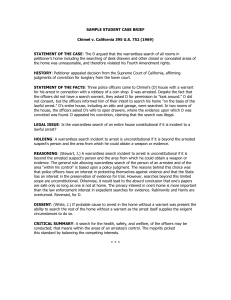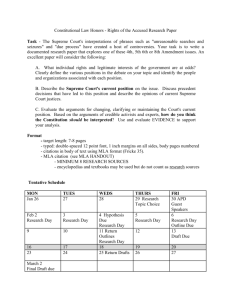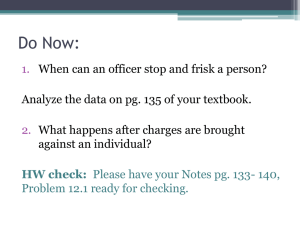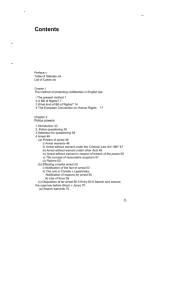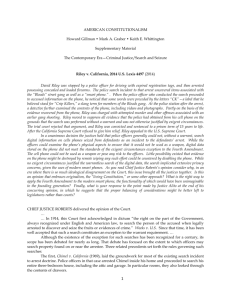the case brief for Chimel v. California
advertisement
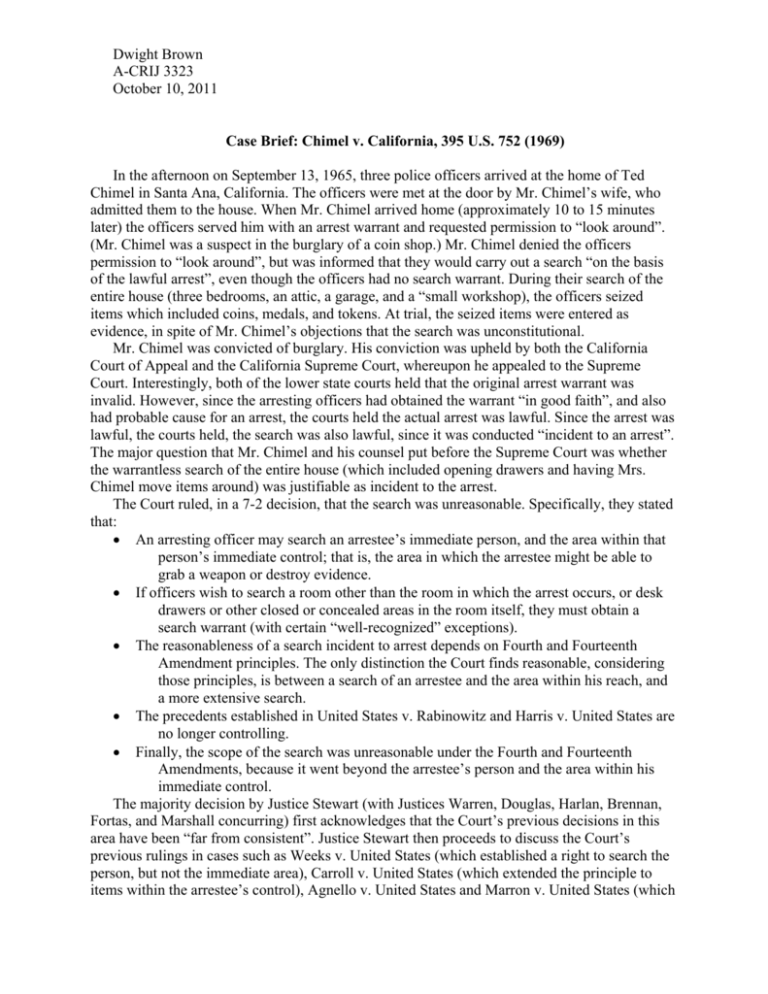
Dwight Brown A-CRIJ 3323 October 10, 2011 Case Brief: Chimel v. California, 395 U.S. 752 (1969) In the afternoon on September 13, 1965, three police officers arrived at the home of Ted Chimel in Santa Ana, California. The officers were met at the door by Mr. Chimel’s wife, who admitted them to the house. When Mr. Chimel arrived home (approximately 10 to 15 minutes later) the officers served him with an arrest warrant and requested permission to “look around”. (Mr. Chimel was a suspect in the burglary of a coin shop.) Mr. Chimel denied the officers permission to “look around”, but was informed that they would carry out a search “on the basis of the lawful arrest”, even though the officers had no search warrant. During their search of the entire house (three bedrooms, an attic, a garage, and a “small workshop), the officers seized items which included coins, medals, and tokens. At trial, the seized items were entered as evidence, in spite of Mr. Chimel’s objections that the search was unconstitutional. Mr. Chimel was convicted of burglary. His conviction was upheld by both the California Court of Appeal and the California Supreme Court, whereupon he appealed to the Supreme Court. Interestingly, both of the lower state courts held that the original arrest warrant was invalid. However, since the arresting officers had obtained the warrant “in good faith”, and also had probable cause for an arrest, the courts held the actual arrest was lawful. Since the arrest was lawful, the courts held, the search was also lawful, since it was conducted “incident to an arrest”. The major question that Mr. Chimel and his counsel put before the Supreme Court was whether the warrantless search of the entire house (which included opening drawers and having Mrs. Chimel move items around) was justifiable as incident to the arrest. The Court ruled, in a 7-2 decision, that the search was unreasonable. Specifically, they stated that: An arresting officer may search an arrestee’s immediate person, and the area within that person’s immediate control; that is, the area in which the arrestee might be able to grab a weapon or destroy evidence. If officers wish to search a room other than the room in which the arrest occurs, or desk drawers or other closed or concealed areas in the room itself, they must obtain a search warrant (with certain “well-recognized” exceptions). The reasonableness of a search incident to arrest depends on Fourth and Fourteenth Amendment principles. The only distinction the Court finds reasonable, considering those principles, is between a search of an arrestee and the area within his reach, and a more extensive search. The precedents established in United States v. Rabinowitz and Harris v. United States are no longer controlling. Finally, the scope of the search was unreasonable under the Fourth and Fourteenth Amendments, because it went beyond the arrestee’s person and the area within his immediate control. The majority decision by Justice Stewart (with Justices Warren, Douglas, Harlan, Brennan, Fortas, and Marshall concurring) first acknowledges that the Court’s previous decisions in this area have been “far from consistent”. Justice Stewart then proceeds to discuss the Court’s previous rulings in cases such as Weeks v. United States (which established a right to search the person, but not the immediate area), Carroll v. United States (which extended the principle to items within the arrestee’s control), Agnello v. United States and Marron v. United States (which Brown 2 extended the principle further), and other cases which alternated between extending and retracting the limits of a search “incident to arrest”. (In particular, Justice Stewart considers Harris v. United States, which allowed police officers to search an entire apartment.) The final case Justice Stewart considers is United States v. Rabinowitz, which allowed officers to search a desk, safe and file cabinets in an office. In that case, the court relied on the Harris precedent to hold that the search was legitimately “incident to arrest”. Justice Stewart is harshly critical of the decision in Rabinowitz, pointing out that it disregarded the decisions in several other cases. He is also critical of the state’s reasoning: The presence of a search warrant serves a high function. Absent some grave emergency, the Fourth Amendment has interposed a magistrate between the citizen and the police. This was done not to shield criminals nor to make the home a safe haven for illegal activities. It was done so that an objective mind might weigh the need to invade that privacy in order to enforce the law. The right of privacy was deemed too precious to entrust to the discretion of those whose job is the detection of crime and the arrest of criminals… Justice Stewart observes that just because the police believe evidence is concealed somewhere within a premises, that does not give them justification for a search without a warrant. He then goes on to outline what the Court views as the limits of a search “incident to arrest”: the person of the arrestee, the area the arrestee may reach into, or in which he might gain possession of a weapon or destructible evidence (the area “within his immediate control”). “There is no comparable justification, however, for routinely searching any room other than that in which an arrest occurs - or, for that matter, for searching through all the desk drawers or other closed or concealed areas in that room itself. Such searches, in the absence of well-recognized exceptions, may be made only under the authority of a search warrant.” Justice Stewart’s emphasis is clearly on the reasons why a search “incident to arrest” is permissible: officer safety or preventing the destruction of evidence. A search has to be “reasonable”, in terms of the “facts and circumstances – the total atmosphere surrounding the case”. While Justice Stewart believes it might be possible to distinguish between the searches in Rabinowitz and Harris, and the search in this case, he sees it as an artificial exercise. “The only reasoned distinction is one between a search of the person arrested and the area within his reach on the one hand, and more extensive searches on the other.” Justice Stewart ends the decision by reversing the precedents in Rabinowitz and Harris, ruling that the search in question was “unreasonable”, and reversing the decision of the lower courts. Justice Harlan wrote a separate concurring opinion. While he agreed with the majority decision, he expressed concern about the burden requiring a warrant would place on local law enforcement. “Thus, one is now faced with the dilemma…of choosing between vindicating sound Fourth Amendment principles at the possible expense of state concerns, long recognized to be consonant with the Fourteenth Amendment before Mapp and Ker came on the books, or diluting the Federal Bill of Rights in the interest of leaving the States at least some elbow room in their methods of criminal law enforcement.” He finds this dilemma difficult to resolve, but ultimately states “in the last analysis I cannot in good conscience vote to perpetuate bad Fourth Amendment law”. Justice White, in his dissenting opinion (joined by Justice Black) argues that there has been a “remarkable instability” in the Court’s position on what is permissible as a “search incident to arrest”. According to White, the majority decision marks the fifth major shift in 50 years; he believes that the Court should provide some stability by sticking with the old rule. In the first Brown 3 part of the minority opinion, Justice White provides a summary of the previous Court decisions that is very similar to that provided by Justice Stewart in the majority decision. In the second section of the dissent, Justice White acknowledges that a “search incident to arrest” is generally limited to the person of the defendant and the area under his immediate control, and outlines the reasons why such searches are considered “reasonable”. However, he believes that just because those reasons do not apply to areas outside of the immediate control of the defendant, these searches are not prima facie “unreasonable”. In particular, the dissenting opinion argues that it is not reasonable to expect police serving an arrest warrant to leave the premises and obtain a separate search warrant. To Justice White, searching an entire premises, incident to an arrest, falls into the area of “exigent circumstances”. For example, “confederates of the arrested man” may destroy or alter evidence while the police are waiting for a search warrant. In the third section of the dissent, Justice White acknowledges that his analysis is based on two assumptions: that the arrest was constitutional (even though the arrest warrant was not valid), and that the police were not required to obtain a search warrant in advance. “But for the arrest, the warrantless search may not be justified.” Further, if the arrest was justified, it seems strange to Justice White that the search would not be; an arrest is far more of an imposition than a mere search of a person’s property. The minority opinion goes on to review the law on warrantless arrests, concluding that Congress has authorized warrantless arrests by federal law enforcement officers. Given this, as well as past history and judicial decisions, Justice White believes that warrantless arrests, and the accompanying searches, are reasonable. In the fourth and final section of the dissent, Justice White agrees that a search of the arrested person and the immediate area under his control is reasonable. He also agrees with the majority that the arrest alone does not furnish probable cause for a more extensive search. “However, where as here the existence of probable cause is independently established and would justify a warrant for a broader search for evidence, I would follow past cases and permit such a search to be carried out without a warrant, since the fact of arrest supplies an exigent circumstance justifying police action before the evidence can be removed, and also alerts the suspect to the fact of the search so that he can immediately seek judicial determination of probable cause in an adversary proceeding, and appropriate redress.” Further, Justice White argues, a person who is under arrest has access to lawyers and judges, and is “in an excellent position to dispute the reasonableness of his arrest and contemporaneous search in a full adversary proceeding”. In this case, I side with the majority opinion. The circumstances that justify a search of a person and the area under his immediate control (officer safety and the protection of others) clearly do not extend to closed drawers, closed containers, and other areas of premises. While there is something seductive to Justice White’s “exigent circumstances” argument, it seems to me that there are ways to prevent the destruction of evidence short of allowing invasive searches; for example, police officers could be left at the premises to observe the occupants while a search warrant is being obtained. Or a search warrant could be obtained at the same time as an arrest warrant. Justices White and Black seem to believe that the convenience of police officers is a “master key” that allows the Fourth Amendment to be pushed out of the way. I side with the majority in rejecting this interpretation of the Constitution.
